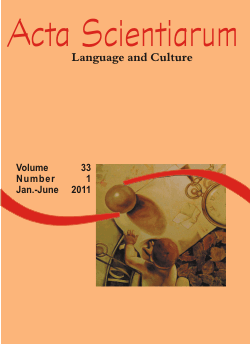<b>De-metaphorizing and becoming animal: when the animal looks back. A reading of Marian Engel’s <em>Bear</em></b> - doi: 10.4025/actascilangcult.v33i1.6251
Abstract
The primacy acquired by nature in our current culture has given way to several issues not strictly connected with an immediate and ‘purely’ ecological interest: there is rather the need to question how we conceive the animal with a focus on the possibility to transcend Western cultural heritage. When trying to give a literary representation of the animal, it is particularly important to adopt some measures which, following the trajectory of a genuine, positive ‘becoming-animal’, will safeguard its independence and avoid reducing it to metaphorically anthropomorphic representations. This essay intends to underline how, from this viewpoint, a few novels coming from the post-colonial area, where animal tales often show how interwoven humans and animals are and how they are constructed in relation to each other supply interesting case studies. My interest focuses particularly on Canadian Marian Engel’s Bear, where the writer tries to deal with unspeakable subjects between a woman and a bear: through an act of radical approach to its physical reality, the former comes first to recognize the latter, and then to accept its Otherness. On its side, the bear seemingly ‘shows’ a post-colonial attitude subversively resisting a typically Western anthropomorphic allegorization. Holding fast to itself and its animality, choosing in a way to ‘stay mute’, the bear keeps the role of a ‘perceptive catalyst’, ‘thought-producing’ and thus ‘world-changing’, according to an aesthetics of perception suggesting that the animal gaze might be the best perspective from which to observe not only our world, but especially our own selves.Downloads
DECLARATION OF ORIGINALITY AND COPYRIGHTS
I Declare that current article is original and has not been submitted for publication, in part or in whole, to any other national or international journal.
The copyrights belong exclusively to the authors. Published content is licensed under Creative Commons Attribution 4.0 (CC BY 4.0) guidelines, which allows sharing (copy and distribution of the material in any medium or format) and adaptation (remix, transform, and build upon the material) for any purpose, even commercially, under the terms of attribution.
Read this link for further information on how to use CC BY 4.0 properly.




















6.png)









